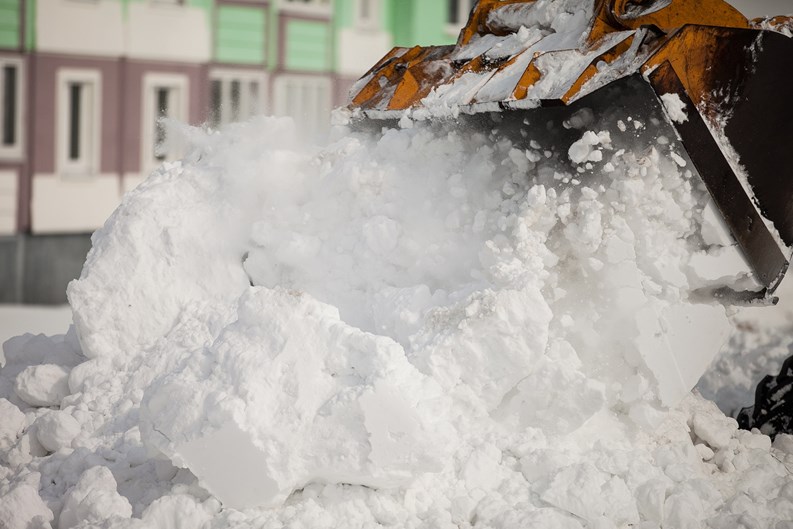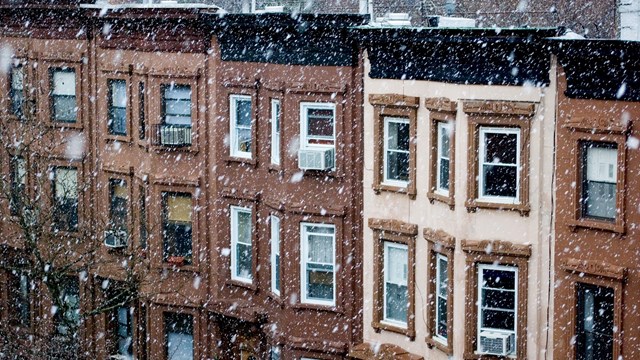Time will tell whether global warming and climate change eventually make winter—and its attendant snow, ice, sleet, and other challenging weather issues—extinct, but for now at least, the colder months can take a seasonal toll on buildings and surrounding property. With the proper planning, forethought, and communication however, building administrators can stay ahead of this sometimes-unpleasant season. With a few tips from experts, you can confidently work to minimize the risks that snow and ice can bring.
Know Your Responsibilities
The first step in making sure your winter season responsibilities don’t catch you by surprise is familiarizing yourself with the specific laws and regulations pertaining to snow and ice maintenance in your area. Responsibilities and potential liabilities for buildings and associations can vary, depending on municipal ordinances, building size and development layout. Even if you are a seasoned property manager, new laws and regulations go into effect sometimes—and sometimes without much (if any) notification. So it definitely pays to do a little bit of research.
Many of the locality-specific requirements can be found on municipal informational websites like www1.nyc.gov for New York City, or mass.gov, which offers state-wide regulations for Massachusetts, as well as a city and town list where you can find specific bylaws and ordinances for your town. New regulations went into effect as of December 28, 2015 for the city of Chicago, according to cityofchicago.org — so even if you think you know your responsibilities for snow removal, it might be a good idea to check in on a municipal website before receiving a potentially costly citation even after you’ve fulfilled your understanding of a previous years’ regulations. Some more suburban townships also have noise ordinance laws in effect, which can make the time you have to clear the snow or ice after the fall ceases a very specific window.
In general, it is safe to assume that all sidewalks, walkways and driveways on and adjacent to the property fall under property management and association responsibility. Working a regulation check into your winter prep period can also help to inform your hiring of potential snow and ice removal contractors. Tom Canete, owner of Canete Snow Management, a snow removal company that serves Manhattan’s five boroughs as well as New Jersey and Westchester, advises that property managers have a sit-down meeting with potential contractors.
“You should ask about their storm action plan,” he says. “Make sure that yours is site specific; and make sure there’s more than one plan” in place for different amounts of snowfall and ice accumulation, because “no two storms are alike.” Canete also advises making sure the company you are interviewing has a good sense of how to handle these differences with multiple plans to put in effect, ranging from small accumulations to state of emergency, 100-year blizzards.
Know Your Property
In addition to municipal laws, individual community culture can also be an area where some preventive education can save headaches in the long run. Aaron Kurdyla, director of operations for High Tech Landscapes, which works with both residential and commercial properties in New Jersey, encourages building administrators to be communicative with members of the building community in terms of setting up personalized individual properties for a successful and safe winter season. Sometimes residents personalize outdoor space with decorations, like statues and other lawn ornamentation that make the property unique. These embellishments can be hidden from view in high snowfall and may become a potential hazard in the clearing of snow along driveways and sidewalks by contractors unfamiliar with these individual property differences.
“As much as you personalize your property, it is still a community, and it is your responsibility as vendors to remove those [decorations] for safety reasons,” says Kurdyla. “The best way to do that is to communicate with residents” about prepping their lawns and driveways for a safe snow and ice removal season. “And don’t be afraid of over-communicating on these issues,” he adds. Preventive care can save residents, contractors, and administrators a lot of money in repairs in the long run.
Stay Ahead of the Season
Knowing when to focus on readiness in terms of snow removal hiring, equipment checks and supply stocks is an important first step for a successfully-managed winter season. Professionals advise starting earlier than you may think. “Typically a lot of communities prepare their contracts in August with the goal of being set by September,” says Kurdyla.
“People are on the beach in August, and I’m ordering salt,” Canete agrees.
Trevor Biebrach, director of operations for Wheeling, Illinois-based Snow Systems Professionals snow and ice removal, offers a similar timetable, adding that building size should be considered in terms of when you start your winter prep.“Start looking early; don’t wait until the last minute,” he warns. “Early September, people should start looking. Bigger management properties probably should probably start in early August. The bigger the property, the earlier you should be looking.” Building administrators shouldn’t worry about overstocking their supply either, according to Canete. “This stuff doesn’t go bad,” he says, but adds that “if you have bagged materials, you need to store them correctly. Make sure all bagged material is under a roof when possible, and at the very least you have air flow” by storing salt on a pallet. The key is to keep it away from rain and sun while storing it for future use.
In choosing a professional removal company, Canete — who also serves as a board director for the Accredited Snow Contractors Association (ASCA) — advises boards and managers to consider how far your contractor will have to travel once the snow starts to fall. “It’s tough to get around in,” he says. “Some of the struggles we have is horrible traffic for Manhattan and the boroughs. The roads shrink in these storms,” which can make travel a problem in blizzard-level conditions.
Municipal Jurisdictions & Maintenance Efforts
It is rare for municipal snow and ice removal personnel to collaborate directly with buildings and contractors when it comes to getting rid of the cold stuff. “The only time I’ve ever seen them connecting together is in the case of a development that has a main road running through it that would run under municipality jurisdiction,” says Canete. Also, most contracts with private clearing companies provide for one clearing per storm. This can be problematic for buildings when the municipal snow clear happens after the private company has fulfilled their contract and some driveways or alleys may become re-covered with the main road dump. Due to timetable restrictions and potential fines, private contractors will often clear client communities’ thoroughfares before municipalities reach the area for their main road obligations. In those cases, Kurdyla advises communicating these potential additional costs to residents and co-op boards as early as possible. “Explain to your community that you are at the mercy of the municipality’s time-table, and let them know that typically, when a contractor has to come back to re-clear a passage that has already been cleared once, there is an additional charge.”
As with any community/contractor relationship, clear communication and goodwill can make a big difference. Canete reminds that the same drivers often have the same routes throughout a season and year after year, so a kind gesture from folks they see regularly can make someone’s day. “Create relationships with the drivers of municipal trucks when you can,” he says. “A cup of coffee goes a long way.”
If you do have trouble with municipal snow-clearing blocking an entrance to an alley or sidewalk, or conflicting with your own clearing efforts, Canete says that “basically, it’s best to wait until a storm or two passes to make sure the municipal clearing works with the private contractor — and if it blocks something, go ahead and call down to the city and get a dialogue going.” Municipal operations often have different priorities in mind than private property managers, and knowing your locality’s specific liability laws can come in handy here as well. As Biebrach says, “City operations tend to take their time and focus on main roads first, and residential roads are cleaned up second. In a city like Chicago this can be risky for property owners, because Chicago has a law where the city cannot be held responsible for any snow-related injuries.” His company works with several municipalities and downtown business district sidewalks, and as a part of their contract they take on all liability for these areas. Regardless of where your building or HOA is located, it’s a good idea to double-check what liabilities the contractor you hire for snow removal will take on at the time of hire.
What Works
Each season brings new tools to the market, and while you may get lucky in experimenting with some of these, there’s agreement that the old reliable tried and true classic ice removal products work the best. “The old materials are just as good as the new stuff,” says Mike Smith of Snow Pros, which services commercial real estate in the New Jersey area. He uses magnesium chloride and bulk salt to make sure his clients’ property is safe and ice-free. Biebrach agrees that “good old basic rock salt works the best,” although he adds that some municipalities are leaning towards the use of the more environmentally-friendly and less-corrosive Calcium Magnesium Acetate (CMA). His company uses Toro brand snow blowers, and says “They’re a good product. We’ve been using them about 10 years.” Canete, whose family-operated business started in 1977, says that sidewalk equipment has come a long way in the last decade “We started off with a shovel, then went to snow blowers. Now there are very sophisticated sidewalk machines that are becoming affordable for independent contractors.” He mentions having worked with Ventrac, Kubota, and Steiner sidewalk machines.
In conclusion, staying ahead of the winter means education, communication, well-stocked supplies, and early bird contract negotiations. These steps can help minimize the risks and potentially costly issues snow and ice accumulation can bring. With early planning and attention to details, you can be sure you’re making every effort to ensure a safe, successful, and smooth winter season for your residents, holiday season guests, and co-workers.
Kristina Valada-Viars is a freelance writer and frequent contributor to The Cooperator.







Leave a Comment